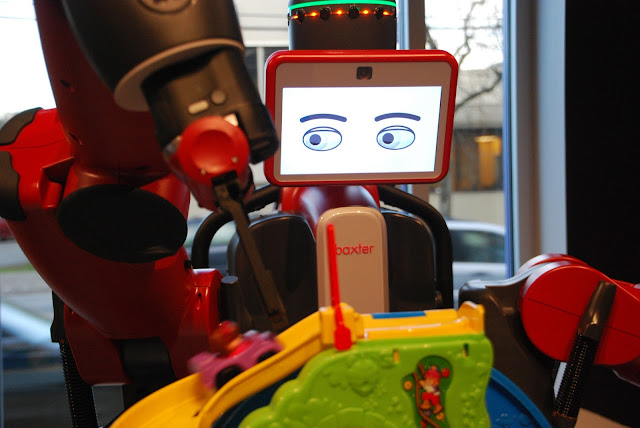It's first Thursday, which means it was free to all, We're members, so that wasn't the draw for us. We go first Thursdays because it's when the museum offers a cool movie. But more on that later.
We got to LCM a bit before 5 and headed straight to the virtual reality corner, as that usually involves a wait.
Annabelle got right in and enjoyed experimenting with the program "Tilt Brush." Art in 3D! What's not to love?
Meanwhile, the rest of us worked ourselves around the rest of the awesome main floor, which includes a 'deep visualization' station where you can hold up items and a learning computer tries to ID it.
Like the Seahawks' season, the computer was close, but not quite good enough.
We also made our way to the Digital Studio - a favorite spot. There are many amazing interactions to be had there, including a station where you use a touch screen to create a circle circus.
We eventually made our way upstairs to the 'old' museum. There we found lovely old computer friends, including this one that could beat me at chess 40 years ago and today. ;)
I loved this poster promo featuring none other than Captain James T. Kirk.
And speaking of Star Trek, when I saw this game on the Commodore 64, I thought, "Geez, that game looks archaic."
I then noticed it came out in 1983. The year I graduated from high school. That means I am completely archaic. ...
After playing our way through the museum, we settled into seats in the theater area to enjoy a documentary, Space Invaders: In Search of Lost Time. I'll let the kids tell you more about it. Annabelle is up first. ...
The Space Invaders: In Search of Lost Time is a movie about the rise and fall of arcades. In the early 80’s arcades were growing huge, and almost every day any kids who had free time would borrow some money and run to the arcade. There were many favorites like Pac-man (which you could almost never get to because there was a huge line), Centipede (which was apparently a favorite among girls), and others like Asteroids and Donkey Kong. What’s sad is that after the initial craze, arcades were being outdone by home consoles that had all the same games. They were kicked out of mall because of the noise and lights, and the kids who were crazed about them had grown up and had less spare time. Fortunately, there are many people who have taken to collecting old arcade machines and restoring them. Some even reproduce and sell replacement parts or run arcades!
The only worry is that they won’t be able to pass the nostalgia to the next generation. But everyone has their own story as to why they collect arcade games. I thought it was great at explaining the rise and fall of the arcade.And here is CJ's take. ...
For the gazillionth time, my family visited the Living Computers Museum + Labs, this time to see a documentary. The film screened was "The Space Invaders: In Search of Lost Time", a documentary about people who collect classic arcade games, and, by extension, the games themselves.
In the early 1980s (and to a lesser extent, the early 1970s), video arcades were all over the place in America. By 1982, there were 13,000 dedicated arcade locations across North America, frequented by players with fistfuls of quarters. In the years since, while classic video game arcades have largely disappeared from malls and city streets, there are still several collectors, dedicated to preserving several of the games that were originally at the arcades, such as classics like Pac-Man, Donkey Kong, Dragon's Lair, and, of course, Space Invaders itself.
The majority of classic arcade game enthusiasts and collectors (unlike me, who was born well after the heyday of arcades) are people who grew up with arcades in their heyday, usually born in the mid-to-late 1960s and early 1970s. While they were not the only demographic at arcades in the 1980s, they are the generation that would be nostalgic for them now. According to The Space Invaders, a museum or collection is largely the transferral of time into space. This is reflected in several arcade collections, where the time (the early 1980s) is transferred into space (as in physical space, usually in the owner's basement or private collection). Some of the collectors interviewed in The Space Invaders described that the collection process works along the lines of this:
You buy your first arcade game for a couple hundred dollars, usually a must-have like Pac-Man or Donkey Kong. You enjoy your new game. You decide that you want to add a new game to your collection every month. You get addicted to collecting. You buy more and more, until you no longer have enough space to store your machines.
As I saw in the film, every collector has a story, as does every machine in their collections. As a Q&A from the film's official website puts it, "These games have brought a couple together, helped someone cope with the untimely passing of a close friend, allowed others to fulfill a childhood dream of running their own arcade, and even more collectors to form a special bond with their children and their extended families."












